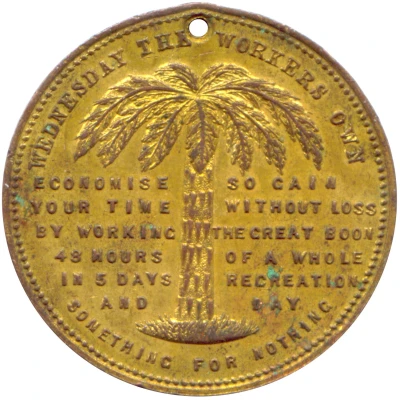


Token - Rational Economy Wednesday ND
| Gold plated brass (Gilt - washed) | 11 g | 31 mm |
| Location | Victoria (Australian States) |
|---|---|
| Queen | Victoria (1837-1901) |
| Type | Trade tokens › Business tokens |
| Years | 1891-1893 |
| Composition | Gold plated brass (Gilt - washed) |
| Weight | 11 g |
| Diameter | 31 mm |
| Thickness | 2 mm |
| Shape | Round (Some pierced) |
| Technique | Milled |
| Orientation | Medal alignment ↑↑ |
| Demonetized | Yes |
| Updated | 2024-11-14 |
| Numista | N#408387 |
|---|---|
| Rarity index | 97% |
Reverse
Palm or Fern Tree
Script: Latin
Lettering:
WEDNESDAY THE WORKERS OWN
ECONOMISE
YOUR TIME
BY WORKING
48 HOURS
IN 5 DAYS
AND
SO GAIN
WITHOUT LOSS
THE GREAT BOON
OF A WHOLE
RECREATION
DAY
SOMETHING FOR NOTHING
Edge
Plain
Comment
This Medal, from Cole's Book Arcade, is one of a series of medals offering maxims and proverbs issued by E.W. Cole at his Book Arcade. He called the medals 'little missionaries for the spread of educative knowledge' (Dean, 1988, p.36).
According to Sydney Endacott, an employee of Cole, customers were charged three pence for these medals (which he prefers to call tokens) which, when the Arcade was particularly busy, gave them admission to the second-hand books gallery where the orchestra played. Each medal could be exchanged for thee pence worth of goods, but most were kept. The pierced ones were sometimes worn as pendants or on pocket watch chains. The medals served as perpetual advertisements of the Arcade (Victorian Historical Magazine, February 1962). George Dean suggests that the medals were also given in change at Christmas time, and could be used to operate amusement machines (presumably including the symphonion and hens, although these only required one penny to operate).
Cole had his first medal struck in 1879 and his last one about 1903. The medals were variously gilded, silvered or bronzed, replicating the coinage then circulating, or plated with nickel or white metal. The medal blanks were usually made of copper or brass, but some might have been bronze; aluminium was also sometimes used. In all, perhaps 300,000 medals were struck, in 97 types. Only 50 types are known to have circulated (George Dean, 1988, A Handbook on E.W. Cole: His Book Arcade, Tokens and Medals).